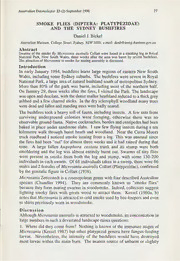Table Of ContentAustrralian Entomologist 23 (2) September 1996 77
SMOKE FLIES (DIPTERA: PLATYPEZIDAE)
AND THE SYDNEY BUSHFIRES
Daniel J. Bickel
Australian Museum, College Street, Sydney, NSW 2000; e-mail: [email protected]
Abstract
Swarms of the smoke fly Microsania australis Collart were found at a smoking log in Royal
National Park, New South Wales, three weeks after the area was burnt by severe bushfires.
The attraction of Microsania to smoke for mating assembly is discussed.
Introduction
In early January 1994, bushfires burnt large regions of eastern New South
Wales, including some Sydney suburbs. The bushfires were severe in Royal
National Park, a large area of natural bushland south of metropolitan Sydney.
More than 80% of the park was burnt, including most of the northern half.
On January 29, three weeks after the fires, I visited the Park. The landscape
was open and desolate, with the dense mallee heathland reduced to a thick grey
ashbed and a few charred sticks. In the dry sclerophyll woodland many trees
were dead and fallen and standing trees were badly seared.
The bushfires took a heavy toll of fauna, including insects. A few ants from
surviving underground colonies were foraging, otherwise there was no
observable ground fauna. Native cockroaches, beetles and centipedes had been
baked in place under sandstone slabs. I saw few flying insects during a ten
kilometre walk through burnt heath and woodland. Near the Curra Moors
track roadhead I noticed smoke issuing from a log. This was unusual since
the fires had been "out" for almost three weeks and it had rained during that
time. A large fallen Angophora costata trunk and its stump were both
smoldering and the log was almost entirely burnt out. Swarms of tiny flies
were present in smoke from both the log and stump, with some 150-200
individuals in each swarm. Of 68 individuals taken in a sweep, there were 66
males and 2 females of Microsania australis Collart (Platypezidae), confirmed
by the genitalic figure in Collart (1938).
Microsania Zetterstedt is a cosmopolitan genus with four described Australian
species (Chandler 1994). They are commonly known as "smoke flies"
because they form mating swarms in woodsmoke. Indeed, collectors suggest
lighting smoky fires with green wood to attract them. Kessel (1960a, b)
notes that Microsania is attracted to cold smoke used by bee-keepers and even
to shirts previously worn in woodsmoke.
Discussion
Although Microsania australis 1s attracted to woodsmoke, its concentration in
large numbers in such a devastated landscape raises questions:
1. Where did they come from? Nothing is known of the immature stages of
Microsania (Kessel 1987) but other platypezid genera have fungus-feeding
larvae. Nevertheless, the intensity of the bushfires would have destroyed
most larvae within the main burn. The nearest source of unburnt or slightly
78 Austrralian Entomologist 23 (2) September 1996
burnt bushland was Bola Creek, 3-4 km to the west.
2. When did they arrive? The main bushfire would have been too hot and
turbulent to attract the flies. I suspect M. australis came into the area after
the main blaze was extinguished but while logs were still smoldering. As
fires died out, the smoke flies probably gathered at remaining smoke, and the
smoldering trunk was possibly the last source over a wide area.
The sex ratio of the M. australis sample (66 CC9, 2 Q9) is typical of an aerial
mating swarm (Downes 1969). In many insects, aerial swarming is initiated
by environmental cues such as light intensity and relative humidity.
However it seems that Microsania spp. use smoke in two ways: as an
aggregating "scent" to concentrate dispersed individuals of both sexes and as a
swarm marker, the actual smoke plume delimiting the swarm boundary
(individuals rarely leave the plume and follow as it shifts).
Kessel (1989) suggested that attraction to smoke was a positive response to
concentrate individuals in areas recently burnt by forest fires, and that
Microsania bred in fungi specifically associated with fire-scarred wood.
However, this hypothesis has yet to be documented, as larvae and their hosts
are unknown. If this were the case, one would expect Microsania to be co-
adapted with fire-ecology vegetation, such as the eucalypt forests of Australia
or chaparral of California. However, smoke flies also occur in northwestern
Europe and Central African rainforest where natural fires are exceedingly rare.
In these moist regions they often appear in large numbers around smoky fires
(e.g. Chandler 1978). Therefore, although Microsania is distinctly attracted
to smoke for mating, it must have other means of aggregation and swarming
in the absence of fire. Possibly they are attracted to certain plant aromatics
which also facilitate aggregation.
References
CHANDLER, P.J. 1978. Some dipterous opportunists at Windsor Forest, Berks.: the attractions
for flies of bonfires, wood ash and freshly cut logs. Entomologists Gazette 29: 253-257.
CHANDLER, P.J. 1994. The Oriental and Australasian species of Platypezidae (Diptera).
Invertebrate Taxonomy 8: 351-434.
COLLART, A. 1938. Description d'un Microsania nouveau d'Australie (Diptera:
Platypezidae). Bulletin Musée royal d'Histoire naturelle de Belgique 14 (16): 1-4.
DOWNES, J.A. 1969. The swarming and mating flight of Diptera. Annual Review of
Entomology 14: 271-298.
KESSEL, E.L. 1960a. The response of Microsania and Hormopeza to smoke (Diptera:
Platypezidae and Empididae). Pan-Pacific Entomologist 36: 67-68.
KESSEL, E.L. 1960b. Microsanias attracted to cold smoke. Wasmann Journal of Biology 18:
312-313.
KESSEL, E.L. 1987. Platypezidae. Pp 681-688, in J.F. McAlpine, et al., Manual of Nearctic
Diptera Vol 2. Research Branch Agriculture Canada Monograph 28, Ottawa, 1332 pp.
KESSEL, E.L. 1989. Autobiographical Anecdotes. Myia 2, San Francisco, 231 pp

